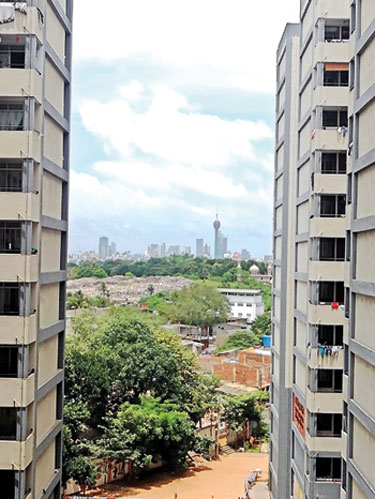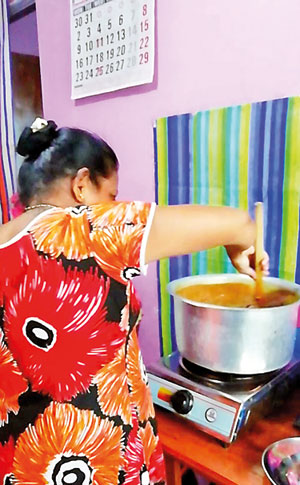Blanket stereotypes ignore resilience of community life

A new way of life: Looking down at the city from a high rise social housing project in Colombo
We sit cross-legged on Vadhani Akka’s balcony as she shreds carrots, leeks and tomatoes on her vegetable cutter with a flourish, preparing lunch for her family of five. Her story is one of dukha (suffering), but her narrative style is triumphant.
“When I was small, we lived in a hut in Manikwatta. There was a sudden announcement, to come and populate the area near the Manikwatta beach. Plots of land were being distributed, and we could claim these within 24 hours. I was only eight years old. I told my Seeya to go and get the stuff to build the house. I would wait and hold the place. I waited and waited seated alone on the hot ground, clutching some takaran pieces in the sun, holding a place for our home, waiting for Seeya to come back.
Vadhani Akka’s circuitous journey of discovering home, saw her at one point, even begging with her three children on the streets of Colombo. Dukha prevailed, but she had been determined to build her home. She had been in the Middle East and “constructed her home well”(hondhata haeduwa). When her watta home was demolished by the government, she came to the state constructed flats (aanduwen gewal kaduwa, flat haduwa).
This was a common statement articulated by residents I spoke to in Crystal Court (my field site) who were relocated from urban wattas into high-rise social housing projects. Despite the multiple disruptions in Vadhani Akka’s life, her story was not one of helplessness and vulnerability, but reflected the resilience and strength of communities within broader development narratives in the city.
Although the Colombo Municipal Council (CMC) and mayoral candidates are currently the central topics of discussion in the aftermath of the local government elections, I direct attention to an often-ignored segment of Colombo’s population. The votes of this population are furiously sought in the run-up to elections but community needs and aspirations are soon forgotten in the aftermath of the elections. Sustainable Development Goal 11 propagates creating sustainable cities and communities and this means seriously considering the needs and aspirations of all communities in the city. While state development projects claim, as discussed in article 1 (the Sunday Times, 04.05.2025) to improve housing for the urban poor in Colombo, their lives remained marginal within the city.
That marginality is not solely based on living in wattas but stems from socio-historical discourses and structural factors related to the urban poor in Colombo. Construction of Colombo as a city was largely influenced by Portuguese, Dutch and British colonial rule. Nihal Perera (2016) in analysing Colombo as a colonial city explains that stigmatisation in Colombo was largely place-based. Anthony King’s commentary (2010) on global colonial cities reveals that cities spatially segregated the White City where the colonisers lived, and the Black City where local social groups were confined. Moreover, colonial urban planning i.e. the Master Plan spatially and racially organised communities in the city.
The chief prelate of the main Buddhist temple in the Crystal Court area explained that this area was originally where the ‘Kaffirs’ (a derogatory term for people of African descent living in Sri Lanka) were exiled. Hence, this highlights how certain urban geographical areas were racially segregated. Certain areas in Colombo were historically demarcated as places of punishment for ‘coloured’ people or for ‘disobedient, alien, unruly’ crowds and to this day, historical stigmatisation reinforces negative perceptions regarding the communities.
Housing for the urban poor in Colombo has included ‘slums and shanties’, wattas, low-cost, low-rise flats and high-rise housing projects which have also contributed to marginality. More recently, the CMC introduced terminology like ‘underserved settlements’ to describe urban housing settlements and reduce pejorative ‘slum and shanty’ connotations (Hettige et al., 2004). ‘Underserved settlements’ transferred responsibility to improve housing and essential services to the state, reducing blame imposed on urban communities for substandard housing. However, when the URP was implemented in 2010, the ‘slums and shanties’ label was reintroduced into popular discourse.

Everyday chores: Cooking for the family
Research by Kalinga Tudor Silva and Karunathissa Athukorala (1991), Sevanatha (2002, 2012), and the combined 2024 survey by Colombo Urban Lab and Sevanatha challenged blanket classifications of ‘slums and shanties’ in Colombo. Despite popular perceptions that the urban poor are ‘squatters’, living on ‘unauthorised land’, many watta residents had claims to the land, and possessed supporting documentation, many houses had been upgraded and formalised with water and electricity facilities. However, the complexities of these wattas were rarely considered in implementing regeneration projects. Often relocation projects were implemented due to the need to have more ‘lucrative’ purposes for the ‘prime land’ on which these communities were located.
Housing, geographical location and historical discourses were not the only factors contributing to the marginal status of urban communities. Oscar Lewis’ (1959) classic ‘culture of poverty’ theory traditionally promoted the idea of inescapable, generational poverty. While these theorisations regarding the urban poor are now being critiqued by social scientists, perceptions of ‘the urban underclasses’ still linger.
Wacquant (2008, 2) in his study on slums in America and France opines that ideological construction of ‘underclasses’ was fundamental to creating the metropolis, where slums were depicted as “hotbeds of violence, vice and social dissolution”. Wacquant asserts that “Marginalisation is a product of class logic, redoubled by ethno-national origin and in part attenuated by state action”.
In my own study, I discovered that class-based and often ethno-national thinking underscored marginalisation and was evident in the language regularly used by state officials regarding the urban poor. Prior to starting fieldwork, I obtained permission to live in a government high-rise from some state organisations and law enforcement officers. While they were quite surprised by my project, I was warned about the nuugath (uneducated), amuthu (strange), charter (useless), kilutu (dirty), bayanaka (dangerous), kuddo (drug addicts) and sakkili (caste-less) communities. Hence, constant stereotyping reinforced the marginality of these urban communities.
Another reason for persisting marginalisation is that high-rise housing projects are often associated with ideas of failure. These ideas often emerge following disasters i.e., the Grenfell Tower disaster identified by the BBC (2019) as one of the UK’s ‘worst modern disasters’. Many high-rises under the URP are also labelled as ‘vertical slums’, and identified as hotspots for crime and drugs. These stereotypes were intensified during COVID-19 with some media organisations creating dramatic footage of residents in high-rises breaking COVID-19 regulations, or publicising entire flats being locked down due to COVID-19, and regularly showing drug raids in the flats. While such incidents do occur in housing projects, these do not reflect everyday realities within these communities.
When I lived in Crystal Court in Colombo, I was intrigued by the social organisation and community formation within the flat. There were floor-based rosters, regular cleaning and washing of the flat and the stairs, samithi meetings to discuss maintenance, and inbuilt community networks that provided community protection. Of course, there were times when these samithis did not function, or when conflicts, and different social issues were prevalent. But the blanket stereotypes imposed on urban poor communities ignored the multifaceted resilience of community life.
Global development narratives, state-driven development projects, and colonial histories often highlight the work of kings and queens, politicians, and rulers and organisations (i.e. the World Bank, the ADB, TATA) and countries (China, India) who construct buildings, towers, highways, roads or high-rises. Development narratives rarely acknowledge people like Vadhani Akka or their agency in developing strong home and communities. These everyday narratives hidden away in marginal urban communities like Crystal Court constitute stories worth telling. For example, Vadhani Akka runs a food stall in the community, she ensures protection for people in the community by keeping an eye on what happens around her, and her resilience and homemaking is inspirational.
Similarly, there are different stories of people in Crystal Court, whether the three-wheeler drivers, naatamis who carry kilos of parippu and Bombay luunu on their backs, port workers who work the night shift, cleaners who work in offices, homes and organisations in Colombo, the workers who tirelessly clear Colombo’s garbage, the tea packers in factories. Not only do these people provide essential services for the city but they also possess a right to the city, to use the city’s resources, and to enjoy the city as urban citizens.
Their developmental contribution is often in stark contrast to the Port Cities and the Lotus Towers, or even the gewal kaeduwa, flat haeduwa type of development which is more attractive to foreign investors and global capital. However, it is the extraordinary strength of these ordinary individuals and their quest to construct strong homes, communities and cities that makes them indispensable to urban development.
(All names of people and places mentioned are pseudonyms)
(Avanka Fernando is based at the Department of Sociology, University of Colombo. Her PhD in Social Anthropology was on “High life in a high rise: An ethnography of home and everyday life in a relocation housing project in Colombo, Sri Lanka”)
Searching for an ideal partner? Find your soul mate on Hitad.lk, Sri Lanka's favourite marriage proposals page. With Hitad.lk matrimonial advertisements you have access to thousands of ads from potential suitors who are looking for someone just like you.


